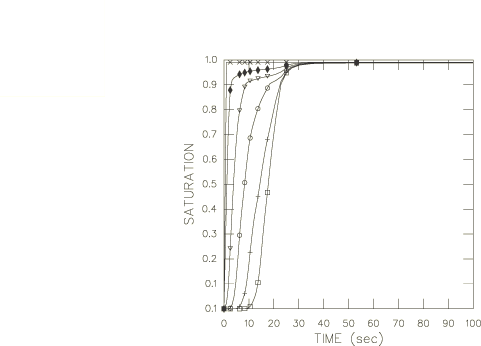In the first step of the analysis we establish stress equilibrium in the
original configuration of the column of material. A stress of 500 Pa is applied
to the mesh to balance the initial pore pressure and saturation conditions. The
effective stress principle
(s is the saturation and u is the
pore pressure) then gives zero effective stresses, ,
for the undeformed configuration.
The “loading” consists of prescribing essentially zero pore pressure
(corresponding to full saturation) at the bottom of the column. This is based
on the assumption that, in the demand wettability test, the sample has
available to it as much fluid as necessary to cause saturation at that point.
This boundary condition is held fixed for 3000 seconds to model the fluid
acquisition process.
The analysis is performed with the transient soils consolidation procedure
using automatic time incrementation. The pore pressure tolerance that controls
the automatic incrementation is set to a large value since we expect the
nonlinearity of the material to restrict the size of the time increments during
the transient stages of the analysis and we do not wish to impose any further
control on the accuracy of the time integration.
The choice of initial time increment in these transient partially saturated
flow problems is important for some element types, to avoid spurious solution
oscillations. This is discussed in
Partially saturated flow in a porous medium.
As discussed in
Coupled Pore Fluid Diffusion and Stress Analysis,
the criterion for a minimum usable time increment in partial-saturation
conditions is
where
is the specific weight of the wetting liquid,
is the initial porosity of the material, k is the fully
saturated permeability of the material,
is the permeability-saturation relationship,
is the rate of change of saturation with respect to pore pressure as defined in
the absorption/exsorption material behavior (Sorption),
and is a
typical element dimension. For our model we have
5.08 mm (the size of an element side),
1.0 × 104 N/m3,
3.7 × 10−4 m/sec, ,
and
5/6. Adjacent to where we apply the fully saturated boundary condition,
elements will span a region from initial to full saturation early in the
transient. A conservative estimate of the minimum time increment is found by
choosing the initial saturation of 0.05. From this, we compute
,
,
and a value of
of about 70 sec. We find, in practice, that an initial increment of 50 sec is
adequate to avoid oscillations in this problem. For the remaining input files
the initial time increment is chosen as discussed in
Partially saturated flow in a porous medium
since we have the same material properties and spatial discretization.
In this analysis the prevailing pore pressure in the medium approaches the
magnitude of the stiffness of the material skeleton elastic modulus. When
reduced-integration elements are used in such cases, the default choice for the
hourglass stiffness control, which is based on a scaling of skeleton material
constitutive parameters, may not be adequate to control hourglassing in the
presence of the relatively large pore pressure fields. An appropriate hourglass
control setting in these cases should scale with the expected magnitude of pore
pressure changes over an element and must be defined explicitly by the user.
Geometric nonlinearities are considered in the analysis since we expect
large deformations due to the growth of the gel particles.







